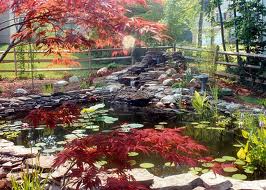





“I am contemplating constructing a koi pool and have been told that it is important to have a drain in the floor, and to flush out regularly. How often do I need to do this?”
A bottom drain is used frequently by some koi keepers as a means of flushing out accumulated debris from the pool floor. Other fish keepers will use a special vacuum cleaner regularly to clear up organic debris. The density of the fish population will have a bearing on how often you need do this. In a moderately populated pool, there is unlikely to be too much organic waste material, so flushing need only be carried out occasionally.
“How do I test my pond’s water to ensure that it is of good quality?”
There are many tests that can be conducted on pond water. However, the most significant are for pH, ammonia and nitrite.
Easy-to-use test kits are available, either in tablet or liquid form, which change the colour of the water. By comparing this with a chart supplied in the kit, it is possible to determine the quality of the water. Good test kits will explain how to interpret the results and resolve any problems. Testing the water regularly will enable you to identify problems in your pond before they become serious enough to cause fish to die.
“What happens if my pond becomes too acid or alkaline? How will it affect the plants and fish?”
In ponds where the water is excessively alkaline, the fish will pick up fungal diseases more readily, as their natural mucus protection will be damaged. The gills of fish can also be damaged by alkalinity, causing them to die, apparently without cause Ammonia compounds in the water also become more toxic, while the ability of a biological filter to work effectively will be reduced. Most plants dislike excessive alkalinity, and often submerged aquatics will become coated with a limy deposit.
Many of the same, or similar, symptoms occur in water that is too acid, although this is a less common condition. Fish will look unhappy and die without apparent reason, although they may show some reddening of the fins. Biological filters also do not perform properly under acid conditions, while many plants do not prosper, especially the submerged aquatics. However, acid-loving marginal plants, such as the cotton grasses, will enjoy the conditions.
In most established pools, where there is a balance of plants and fish, neither excessive alkalinity nor acidity is likely to be a problem. However, in a koi pond, a mush closer check must be kept on the situation, for the quality of water in such an environment is more finely balanced and can easily be tipped either way unexpectedly. If necessary, use a proprietary pH adjuster to correct the pH level of the water, at the same time taking action to identify and correct the cause of the problem.
“Which is the best kind of filter to use to rid my pool of green water?”
The only form of filtration that will provide a reliable cure for green water is an ultra-violet (UV) system. Most other filters are unable to remove tiny, often uni-cellular, algae by straining them out. However, exposing them to ultra-violet light causes the algal cells to unite into larger bodies, which can be captured by a normal foam filter medium.
“I believe that the flow rate of water through a garden pond filter is quite critical. How does this affect its performance, and how do I know that I have got it right?”
 The correct flow rate largely depends upon the manufacturer’s recommendation. It is not something that is easily calculated by the domestic gardener, although it is important to understand the effects of too slow or fast a flow rate.
The correct flow rate largely depends upon the manufacturer’s recommendation. It is not something that is easily calculated by the domestic gardener, although it is important to understand the effects of too slow or fast a flow rate.
If the flow rate is too rapid, it will disturb the aerobic bacteria in the biological part of the system, and in natural filters, it will create inefficiencies by stunting vegetative growth. When the flow rate is sluggish, the weak current is unlikely to be sufficient to move debris towards the drains. A weak flow rate also creates layers in the water, reducing the efficiency of the filter as well as affecting the oxygen content of the pool depths.
“What is a venturi? I have been told that I need one for my koi pool, but what does it do?”
A venturi is a gadget that can be attached to the outflow of a pool filtration system to increase the water’s oxygen content. It creates a vacuum that sucks in air, which is mixed with the water, this being regulated quite simply. As koi have a very high oxygen requirement, the addition of such a device will prove very useful, but it is not essential.
Copyright © www.100flowers.win Botanic Garden All Rights Reserved